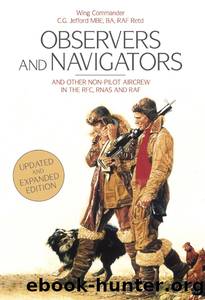Observers and Navigators by Wg Cdr C.G. Jefford

Author:Wg Cdr C.G. Jefford
Language: eng
Format: epub
Tags: HISTORY / Military / Aviation
ISBN: 9781909808409
Publisher: Grub Street Publishing
Published: 2014-05-18T16:00:00+00:00
The replacement of Coastal Command’s three-man Blenheims with two-seat Beaufighters created a demand for observers who were capable of handling Morse at speeds previously associated only with professional wireless operators. This one is R2198 of No 252 Sqn.
1941. The introduction of the Observer (W/T).
At much the same time as Fighter Command’s unique requirements were being satisfied by the creation of the specialist category of the observer (radio), HQ Coastal Command was facing a rather similar issue. Coastal Command’s heavy fighter squadrons had originally been equipped with three-man Blenheims but by the spring of 1941 these were being superseded by two-man Beaufighters. When this had happened in Fighter Command the tendency had been for many of the WOp/AGs already on strength to be retained as AI operators, at the expense of observers who became surplus to requirements. The opposite occurred in Coastal Command where long-range operations over the sea dictated the retention of the skills of a professional navigator. By the summer, it was apparent that this had left a serious gap in capability, because effective long-range communications implied the use of Morse at, at least, eighteen words per minute. Since an observer’s (and a pilot’s) ability to read Morse peaked at only eight words per minute during training (and will probably have tended to deteriorate thereafter) it was clear that neither pilots nor observers were able to handle this task adequately.
The solution was to train selected observers as wireless operators to create the sub-specialisation of the observer (W/T) who was to wear a standard flying ‘O’. Having previously undertaken a fourteen-week signals course after passing through an Initial Training Wing (ITW), the first batch of observers (W/T) began their eight-week navigation course at No 6 Air Observers Navigation School (AONS) at Staverton on 30 August 1941.66 The provisional syllabus, to which should be added 60 hours of air exercises, is sumarised at Figure 28.67
Download
This site does not store any files on its server. We only index and link to content provided by other sites. Please contact the content providers to delete copyright contents if any and email us, we'll remove relevant links or contents immediately.
| Automotive | Engineering |
| Transportation |
Whiskies Galore by Ian Buxton(41879)
Introduction to Aircraft Design (Cambridge Aerospace Series) by John P. Fielding(33064)
Small Unmanned Fixed-wing Aircraft Design by Andrew J. Keane Andras Sobester James P. Scanlan & András Sóbester & James P. Scanlan(32743)
Craft Beer for the Homebrewer by Michael Agnew(18140)
Turbulence by E. J. Noyes(7936)
The Complete Stick Figure Physics Tutorials by Allen Sarah(7307)
Kaplan MCAT General Chemistry Review by Kaplan(6867)
The Thirst by Nesbo Jo(6827)
Bad Blood by John Carreyrou(6552)
Modelling of Convective Heat and Mass Transfer in Rotating Flows by Igor V. Shevchuk(6391)
Learning SQL by Alan Beaulieu(6211)
Weapons of Math Destruction by Cathy O'Neil(6146)
Man-made Catastrophes and Risk Information Concealment by Dmitry Chernov & Didier Sornette(5921)
Digital Minimalism by Cal Newport;(5664)
Life 3.0: Being Human in the Age of Artificial Intelligence by Tegmark Max(5474)
iGen by Jean M. Twenge(5366)
Secrets of Antigravity Propulsion: Tesla, UFOs, and Classified Aerospace Technology by Ph.D. Paul A. Laviolette(5309)
Design of Trajectory Optimization Approach for Space Maneuver Vehicle Skip Entry Problems by Runqi Chai & Al Savvaris & Antonios Tsourdos & Senchun Chai(5011)
Pale Blue Dot by Carl Sagan(4912)
